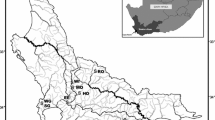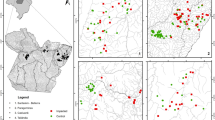Abstract
Southwestern Australia has already undergone significant climatic warming and drying and water temperatures are increasing particularly in small streams where riparian vegetation has been cleared. The ability to predict how freshwater fauna may respond to these changes requires understanding of their thermal tolerances. A review of relevant literature and laboratory testing of four aquatic species from southwestern Australia were used to compare upper thermal tolerance (UTT) among key taxonomic groups. UTT for selected species determined by LT50 tests were similar to that of species tested elsewhere. Mean UTT, based on relevant literature and LT50 experiments, ranged from 22.3°C for Ephemeroptera to 43.4°C for Coleoptera. Mean UTT for both Coleoptera and Odonata (41.9°C) were significantly higher than those for all the other groups (22.3–31.5°C) with the exception of Planaria. The mean UTT value of 22.3°C for Ephemeroptera was significantly lower than for Decapoda (29.6°C), Trichoptera (30.1°C) and Mollusca (31.5°C). For three insect orders tested, eurytherms had significantly higher UTT values than stenotherms. The variation in UTT among taxa suggests that additional thermal shifts, caused by riparian disturbance and/or climate change, are likely to create novel assemblages due to the replacement of temperature-sensitive taxa by more tolerant taxa. This has implications for the sustainability of regionally important endemic cool water species.


Similar content being viewed by others
References
Armstrong, K. N., A. W. Storey & P. M. Davies, 2005. Effects of catchment clearing and sedimentation on macroinvertebrate communities of cobble habitats in freshwater streams of south Western Australia. Journal of the Royal Society of Western Australia 88: 1–11.
Bernhardt, E. S., M. A. Palmer, J. D. Allan, G. Alexander, K. Barnas, S. Brooks, J. Carr, S. Clayton, C. Dahm, J. Follstad-Shah, D. Galat, S. Gloss, P. Goodwin, D. Hart, B. Hassett, R. Jenkinson, S. Katz, G. M. Kondolf, P. S. Lake, R. Lave, J. L. Meyer, T. K. O’Donnell, L. Pagano, B. Powell & E. Sudduth, 2005. Synthesizing U.S River Restoration Efforts. Science 308: 636–637.
Buchanan, J. A., B. A. Stewart & B. R. Davies, 1988. Thermal acclimation and tolerance to lethal high temperature in the mountain stream amphipod Paramelita nigroculus (Barnard). Comparative Biochemistry and Physiology 89A: 425–431.
Bunn, S. E. & P. M. Davies, 1990. Why is the stream fauna of southwestern Australia so impoverished? Hydrobiologia 194: 169–176.
Bunn, S. E. & P. M. Davies, 1992. Community structure of the macroinvertebrate fauna and water chemistry of a salinised river system in south-western Australia. Hydrobiologia 248: 143–160.
Bunn, S. E., P. M. Davies & T. D. Mosisch, 1999. Ecosystem measures of river health and their response to riparian and catchment degradation. Freshwater Biology 41: 333–345.
Calosi, P., D. T. Bilton, J. I. Spicer & A. Atfield, 2008. Thermal tolerance and geographical range size in the Agabus brunneus group of European diving beetles (Coleoptera: Dytiscidae). Journal of Biogeography 35: 295–305.
Calosi, P., D. T. Bilton, J. I. Spicer, S. C. Votier & A. Atfield, 2010. What determines a species’ geographical range? Thermal biology and latitudinal range size relationships in European diving beetles. Journal of Animal Ecology 79: 194–204.
Catford, J. A., R. J. Naiman, L. E. Chambers, J. Roberts, M. Douglas & P. Davies, 2012. Predicting novel riparian ecosystems in a changing climate. Ecosystems. doi:10.1007/s10021-012-9566-7.
Clarke, K. R., 1993. Non-parametric multivariate analyses of changes in community structure. Australian Journal of Ecology 18: 117–143.
Claussen, D. L., 1980. Thermal acclimation in the crayfish, Orconectes rusticus and O. virilis. Comparative Biochemistry and Physiology 66A: 377–384.
Claussen, D. L. & L. M. Walters, 1982. Thermal acclimation in the freshwater planarians Dugesia tigrina and D. dorotocephala. Hydrobiologia 94: 231–236.
Cox, T. J. & J. C. Rutherford, 2000. Thermal tolerances of two stream invertebrates exposed to diurnally varying temperature. New Zealand Journal of Marine and Freshwater Research 34: 209–215.
CSIRO, 2007. Climate Change in Australia, Technical Report 2007. CSIRO Bureau of Meteorology, Melbourne, Victoria, Australia.
Davenport, M. W. & M. J. Simons, 1985. Waikato coal fired power station investigation: review of aquatic invertebrate monitoring at Huntly and thermal tolerance studies. Waikato Valley Authority Technical Report 1985/6, Hamilton, New Zealand.
Davies, P. M., 2010. Climate change implications for river restoration in global biodiversity hotspots. Restoration Ecology 18: 261–268.
Davies, P. M., T. Walshe & B. Cook, 2004. Managing high in-stream temperatures using riparian vegetation. River and Riparian Land Management Technical Guideline, Number 7. Land and Water Australia, Canberra.
Davies, P. M., S. E. Bunn & S. K. Hamilton, 2008. Primary production in tropical streams and rivers. In Dudgeon, D. (ed.), Tropical Stream Ecology, Chap. 2. Elsevier Inc, Amsterdam: 23–42.
De Deckker, P., 1986. What happened to the Australian aquatic biota 18,000 years ago? In De Deckker, P. & W. D. Williams (eds), Limnology in Australia. CSIRO Publishing, Melbourne.
De Kowzlowski, S. J. & D. L. Bunting, 1981. A laboratory study of the thermal tolerance of four south-eastern stream insect species (Trichoptera, Ephemeroptera). Hydrobiologia 79: 141–145.
Ernst, M. R., T. L. Beitnger & K. W. Stewart, 1984. Critical thermal maxima of nympha of three Plecoptera species from an Ozark foothill stream. Freshwater Invertebrate Biology 3: 80–85.
Gallepp, G. W., 1977. Responses of caddisfly larvae (Brachycentrus spp.) to temperature, food availability and current velocity. American Midland naturalist 98: 59–84.
Garten, C. T. & J. B. Gentry, 1976. Thermal tolerance of dragonfly nymphs. II. Comparison of nymphs from control and thermally altered environments. Physiological Zoology 49: 206–213.
Gaufin, A. R. & S. Hern, 1971. Laboratory studies on tolerance of aquatic insects to heated waters. Journal of Kansas Entomological Society 44: 240–245.
Groves, C. R., E. T. Game, M. G. Anderson, M. Cross, C. Enquist, Z. Ferdana, E. Girvetz, A. Gondor, K. R. Hall, J. Higgins, R. Marshall, K. Popper, S. Schill & S. L. Shafer, 2012. Incorporating climate change into systematic conservation planning. Biodiversity and Conservation 21: 1651–1671.
Heiman, D. R. & A. W. Knight, 1972. Upper-lethal temperature relations of nymphs of the stonefly, Paragnetina media. Hydrobiologia 39: 479–493.
Hennessy, K., B. Fitzharris, B. C. Bates, N. Harvey, S. M. Howden, L. Hughes, J. Salinger & R. Warrick, 2007. Australia and New Zealand. Climate change 2007: impacts, adaptation and vulnerability. In Parry, M. L., O. F. Canziani, J. P. Palutikof, P. J. van der Linden & C. E. Hanson (eds), Contribution of Working Group II to the Fourth Assessment Report of the Intergovernmental Panel on Climate Change. Cambridge University Press, Cambridge: 507–540.
Hobbs, R. J., E. Higgs & J. A. Harris, 2009. Novel ecosystems: implications for conservation and restoration. Trends Ecology and Evolution 24: 599–605.
Horne, A. J. & C. R. Goldman, 1994. Limnology, 2nd ed. McGraw-Hill Inc, New York.
Horwitz, P., D. Bradshaw, S. Hopper, P. Davies, P. Froend & F. Bradshaw, 2008. Hydrological change escalates risk of ecosystem stress in Australia’s threatened biodiversity hotspot. Journal of the Royal Society of Western Australia 91: 1–11.
Jacobsen, D., R. Schultz & A. Encalada, 1997. Structure and diversity of stream invertebrate assemblages: the influence of temperature with altitude and latitude. Freshwater Biology 38: 247–261.
Kilgour, D. M. & R. W. McCauley, 1986. Reconciling the two methods of measuring upper lethal temperatures in fishes. Environmental Biology of Fishes 17: 281–290.
Lutterschmidt, W. I. & V. H. Hutchison, 1997. The critical thermal maximum: history and critique. Canadian Journal of Zoology 75: 1561–1574.
Martin, W. J. & J. B. Gentry, 1974. Effect of thermal stress on dragonfly nymphs. In Gibbons, J. W. & R. R. Sharitz (eds), Thermal Ecology. Atomic Energy Commission, Oak Ridge.
McBride, G. B, J. G. Cooke, A. B. Cooper & C. M. Smith, 1993: Optimizing the compensation flow requirements of a river impounded for water supply. In: Rivers for Our Future. Department of Irrigation and Drainage, Kuala Lumpur, Malaysia, November 1993: pp. 4B/1/1-15.
McKie, B. G., P. S. Cranston & R. G. Pearson, 2004. Gondwanan mesotherms and cosmopolitan eurytherms: effects of temperature on the development and survival of Australian Chironomidae (Diptera) from tropical and temperate populations. Marine and Freshwater Research 55: 759–768.
McKie, B. G., R. G. Pearson & P. S. Cranston, 2005. Does biogeographical history matter? Diversity and distribution of lotic midges (Diptera: Chironomidae) in the Australian Wet Tropics. Austral Ecology 30: 1–13.
Moulton, S. R., T. L. Beitinger, K. W. Stewart & R. J. Currie, 1993. Upper temperature tolerance of four species of caddisflies (Insecta: Trichoptera). Journal of Freshwater Ecology 8: 193–197.
Nakata, K., H. Kazuyoshi, T. Hamano, K.-I. Hayashi & T. Kawai, 2002. Lethal limits of high temperature for two crayfishes, the native species Cambaroides japonicus and the alien species Pacifastacus leniusculus in Japan. Fisheries Science 68: 763–767.
Nebeker, A. V. & A. E. Lemke, 1968. Preliminary studies on the tolerance of aquatic insects to heated waters. Journal of the Kansas Entomological Society 41: 413–418.
Osborne, L. L. & D. A. Kovacic, 1993. Riparian vegetated buffer strips in water quality restoration and stream management. Freshwater Biology 29: 243–258.
Price, P., L. Lovett & P. Davies, 2008. National Synthesis of River Restoration Projects: A study undertaken for the National Water Commission within the Water Dependent Ecosystems Theme of the Raising National Water Standards Program. Canberra, ACT, Australia. ISBN 978-1-921107-89-4.
Quinn, J. M., G. L. Steele, C. W. Hickey & M. L. Vickers, 1994. Upper thermal tolerances of twelve New Zealand stream invertebrate species. New Zealand Journal of Marine and Freshwater Research 28: 391–397.
Rutherford, J. C., S. Blackett, C. Blackett, L. Saito & R. J. Davies-Colley, 1997. Predicting the effects of shade on water temperature in small streams. New Zealand Journal of Marine and Freshwater Research 31: 707–721.
Rutherford, J. C., N. A. Marsh, P. M. Davies & S. E. Bunn, 2004. Effects of patchy shade on stream water temperatures; how quickly do small streams heat and cool? Marine and Freshwater Research 55: 737–748.
Simons, M., 1984. Species-specific responses of freshwater organisms to elevated water temperatures. Waikato Valley Authority Technical Publication 29, Hamilton.
Theurer, F. D., I. Lines & T. Nelson, 1985. Interaction between riparian vegetation, water temperature and salmonid habitat in the Tucannon River. Water Resources Bulletin 21: 53–64.
Tukey, J. W., 1977. Exploratory Data Analysis. Addison-Wesley, New York.
Walther, G.-R., A. Roques, P. E. Hulme, M. T. Sykes, P. Pyšek, I. Kühn, M. Zobel, S. Bacher, Z. Botta-Dukát, H. Bugmann, B. Czúcz, J. Dauber, T. Hickler, V. Jarosík, M. Kenis, S. Klotz, D. Minchin, M. Moora, W. Nentwig, J. Ott, V. E. Panov, B. Reineking, C. Robinet, V. Semenchenko, W. Solarz, W. Thuiller, M. Vilà, K. Vohland & J. Settele, 2009. Alien species in a warmer world: risks and opportunities. Trends in Ecology & Evolution 24: 686–693.
Ward, J. V. & J. A. Stanford, 1982. Thermal response in the evolutionary ecology of aquatic insects. Annual Review of Entomology 27: 97–117.
Winterbourn, M. J., 1969. Water temperature as a factor limiting the distribution of Potamopyrgus antipodarum (Gastropoda-Prosobranchia) in the New Zealand thermal region. New Zealand Journal of Marine and Freshwater Research 3: 453–458.
Acknowledgments
We thank the Department of Agriculture and Food, Western Australia for laboratory facilities and The University of Western Australia, Centre of Excellence in Natural Resource Management for administrative support. This work (Project Number FW-11-01) was financially supported by the National Climate Change Adaption Research Facility (NCCARF) under the Climate Change Adaptation Research Grants Program (ARGP) 2011. We thank two anonymous reviewers for their helpful comments.
Author information
Authors and Affiliations
Corresponding author
Additional information
Handling editor: Sonja Stendera
Rights and permissions
About this article
Cite this article
Stewart, B.A., Close, P.G., Cook, P.A. et al. Upper thermal tolerances of key taxonomic groups of stream invertebrates. Hydrobiologia 718, 131–140 (2013). https://doi.org/10.1007/s10750-013-1611-9
Received:
Revised:
Accepted:
Published:
Issue Date:
DOI: https://doi.org/10.1007/s10750-013-1611-9




